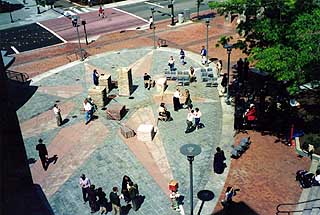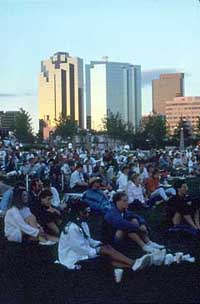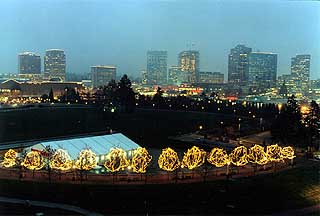
Urban Development
DJC.com
Next >
Back <
Bellevue grows up
Eastside city rapidly changing from suburban to urban
By JOE NABBEFELD
Journal Real Estate Editor
An open-air cafe on the edge of the central plaza bustles with chattering diners and scurrying waiters. Suits, secretaries and skateboarders whisk past the nearby fountain. Ahh, the best of urban life.

|
Except this isn't downtown Seattle. It's downtown Bellevue, which is undergoing a strikingly rapid transformation from a big-block-impaired doormat to Bellevue Square into a real, even foot-traffic-friendly, downtown.
Remember that 1996 Urban Land Institute report that said the city had to find a way to make downtown Bellevue pedestrian friendly -- or else?
It's happening, though not without a lot more head scratching to come on how to deal with the downtown's pedestrian-unfriendly super-sized blocks and the clogging of Interstate 405.
But to see how things are changing take a sunny summertime stroll from the transit center west on the Sixth Street Pedestrian Corridor to Bellevue Square and the impending new Bellevue Art Museum.
What's New?
One new office skyscraper opened this year: Key Center.
Two large office complexes are well into construction: the mid-rise Civica Office Commons and 112th @ 12th. A third, a 40-story tower over a major retail podium in the huge mixed-use Lincoln Square project, recently started construction. And other office towers are teed up to enter construction soon: Technology Tower and The Summit.
Behind these, a pack of six more office proposals are jostling for position. Surely not all will get built in this cycle, at the beginning of which Bellevue had just six major office towers.
A variety of compelling companies have committed to occupy the ones under construction, among them Drugstore.com and Homegrocer.com. City planners project the number of people working in downtown Bellevue will swell from 22,257 in 1990 to 33,600 at the end of this year and 43,100 by 2010.
Each of these projects would provide new street-level shops and restaurants, joining a 100,000-square-foot expansion of Bellevue Square, which is remolding itself in a more urban style along with the rest of downtown.
Apartments and condo buildings, both mid- and high-rise, are filling in throughout downtown at a faster rate than just about anybody imagined. While 1,182 people lived in downtown Bellevue in 1990, city planners project that to more than quadruple to 4,900 by the end of this year and exceed 8,900 by 2010 -- although planners expect to revise these projections upward soon.
Downtown had 654 housing units in 1990. That should reach 3,500 by year-end and 6,600 by 2010, according to city estimates.
The transit center is set for an expansion.
The downtown convention center, called Meydenbauer Center, is scheduled to double in size.
Two hotels, a Ritz and a Marriott, are planned to go in as part of the Meydenbauer expansion in a mixed-use project called Palladium Center. A third new luxury hotel, a Westin, is planned in the huge Lincoln Square project.
The current poster project for downtown Bellevue's surging urbanization is the Safeway store on Bellevue Way. For now, the store could easily be mistaken for a bowling alley separated from the street by a large parking lot. The store floats, as much of downtown Bellevue did until not long ago, in a sea of asphalt that is about as pleasant to stroll through as the shoulder of Interstate 405.
Safeway plans to build a bigger, modernized store on an adjacent site to the south. The new store would extend to the street, over underground parking and provide a base for more than 100 new apartments. Bellevue Square owner Kemper Freeman would then take control of the old store and likely build urban retail and housing there, too.
Bellevue Way by then would look nothing like it does today. At least two high-end condo or apartment buildings are expected to go up across the street on the periphery of Downtown Park and the city plans to jazz up the park's main entry.
The new museum is going up immediately north of the old Safeway, on the Pedestrian Corridor. Lincoln Square is north of the museum. |
Sip a latte in the airy lobby of the new Key Center, people-watch at the new Compass Plaza and study the intriguing architecture taking shape at the art museum. This year the pedestrian corridor has become, for an increasing number of Bellevue downtowners, a great walk.
After Bellevue Square, cut over to Downtown Park, quickly being bounded by brassy condos and apartments. Refuel with a croissant south of the park in the quaint Old Downtown district. Or head north into the high-end apartment district springing up around the design-award-winning King County Library.
"It really is amazing," said Peter Armato, president of the Bellevue Downtown Association. Armato prefers to call the pedestrian corridor "The Promenade" because "corridor sounds so dark."
"We took our board members for a tour recently," Armato said. "They said it was eye-opening."
Bellevue's urbanization faces plenty of obstacles, though, chief among them: overcoming the oversized blocks, estimated to be about four times the size of blocks in downtown Portland. Suggestions include opening up streets, plazas and walkways through the superblocks as they get redeveloped.

|
Aigner recently returned from a holiday in Greece and Italy.
"In Rome, there's that sense of wonderment about what the next bend in the street will bring," he said. "What will I find if I turn this corner? Bellevue, unfortunately, was built for cars, not pedestrians."
Aigner floated the idea of a trolley loop. He also said more pubs and other "third places" would help.
Bellevue's unusually wide streets compound the problem. Ideas for fixes include making some of them one-way to installing a trolley loop around downtown.
The street widths and block lengths were designed that way in the 1950s to streamline the flow of cars straight from the highway into Bellevue Square, then a thoroughly suburban mall surrounded mostly by orchards. Bigger blocks meant fewer stoplights to slow the cars.
Bellevue incorporated in 1952. Development through the 1970s followed the same pattern of catering exclusively to cars. For example, zoning for many parcels required at least five parking spaces per 1,000 square feet of commercial building.
Change began in the late 1970s, as the need arose to plan for higher density. A downtown plan passed in 1981 called for a wedding cake configuration, with the tallest buildings at the center. It decreased the required number of parking spaces.
Five skyscrapers went up in the 1980s. Then development stalled until the market started heating up in 1996. The tech boom brought things to a boil last year.
Longtime Bellevue real estate investor, developer and civic leader Bob Wallace thinks the most important planning has been done to set downtown on the path toward pedestrian friendliness.
"I think very little needs to be done," Wallace said. "Remember the old saw that the electorate is never safe when the Legislature is in session. Bellevue planned itself very thoroughly, some would say ad nauseam. It slugged out some very hard battles. Downtown Bellevue has become a very desirable place. Even traffic is less of a problem than anywhere else in the county."
Scott Wyatt, CEO of the large Seattle architecture firm NBBJ, said more urbanization of downtown is the key to improving traffic flow.

|
"Density is the best solution to traffic. Density and growth management," Wyatt said. "We've got a lot of space there in downtown Bellevue. We need downtown Bellevue and Seattle to be those density hubs."
An influx of high-tech companies into downtown Bellevue promises to help, too, he said.
"CEOs are telling us: 'Give me an environment that fosters creativity,'" Wyatt said. "The urban environment itself does that."
The companies moving into downtown Bellevue want play areas for employees, stimulating entertainment, good restaurants and vibrant pedestrian areas, he said.
"Companies that built these greenfield corporate campus headquarters are learning that they become brain dead," Wyatt said. "They become inbred."
Top | Back | Urban Development | DJC.com Copyright ©1995-2000 Seattle Daily Journal and djc.com.
Comments? Questions? Contact us.